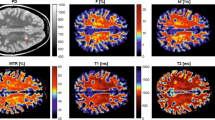Abstract
Conventional magnetic resonance imaging (MRI) has markedly increased our ability to detect the macroscopic abnormalities of the brain and spinal cord in patients with multiple sclerosis (MS). Magnetization transfer imaging and diffusion-weighted imaging have the potential to provide relevant and complementary information on the structural changes occurring within and outside these lesions and are contributing significantly to our understanding of the mechanisms leading to the accumulation of irreversible neurological disability in MS patients. These present review will summarize the major results achieved with the application of these two MR techniques to the assessment of the evolution of MS.
Similar content being viewed by others
Author information
Authors and Affiliations
Rights and permissions
About this article
Cite this article
Filippi, M. The role of magnetization transfer and diffusion-weighted MRI in the understanding of multiple sclerosis evolution. Neurol Sci 21 (Suppl 2), S877–S881 (2000). https://doi.org/10.1007/s100720070030
Issue Date:
DOI: https://doi.org/10.1007/s100720070030




